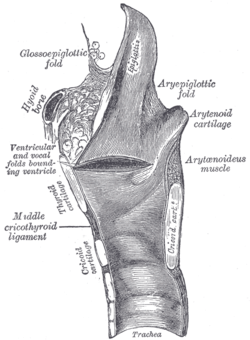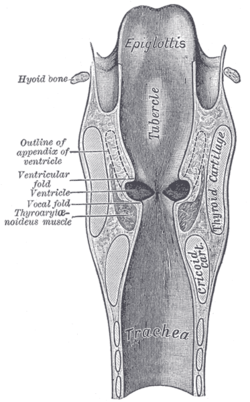Laryngeal cavity
The laryngeal cavity (cavity of the larynx) extends from the laryngeal inlet downwards to the lower border of the cricoid cartilage where it is continuous with that of the trachea.[1][2]
| Laryngeal cavity | |
|---|---|
 Sagittal section of the larynx and upper part of the trachea. | |
 Coronal section of larynx and upper part of trachea. | |
| Details | |
| Identifiers | |
| Latin | cavitas laryngis |
| TA | A06.2.09.001 |
| FMA | 55263 |
| Anatomical terminology | |
It is divided into two parts by the projection of the vocal folds, between which is a narrow triangular opening, the rima glottidis.
The portion of the cavity of the larynx above the vocal folds is called the vestibule; it is wide and triangular in shape, its base or anterior wall presenting, however, about its center the backward projection of the tubercle of the epiglottis.
It contains the vestibular folds, and between these and the vocal folds are the ventricles of the larynx.
The portion below the vocal folds is called the infraglottic cavity. It is at first of an elliptical form, but lower down it widens out, assumes a circular form, and is continuous with the tube of the trachea.
References
- "Pharynx" Emory University Anatomy Manual. Retrieved 2015-09-10.
- "Chapter 53: The pharynx and larynx" Basic Human Anatomy. Retrieved 2015-09-10.
This article incorporates text in the public domain from page 1078 of the 20th edition of Gray's Anatomy (1918)